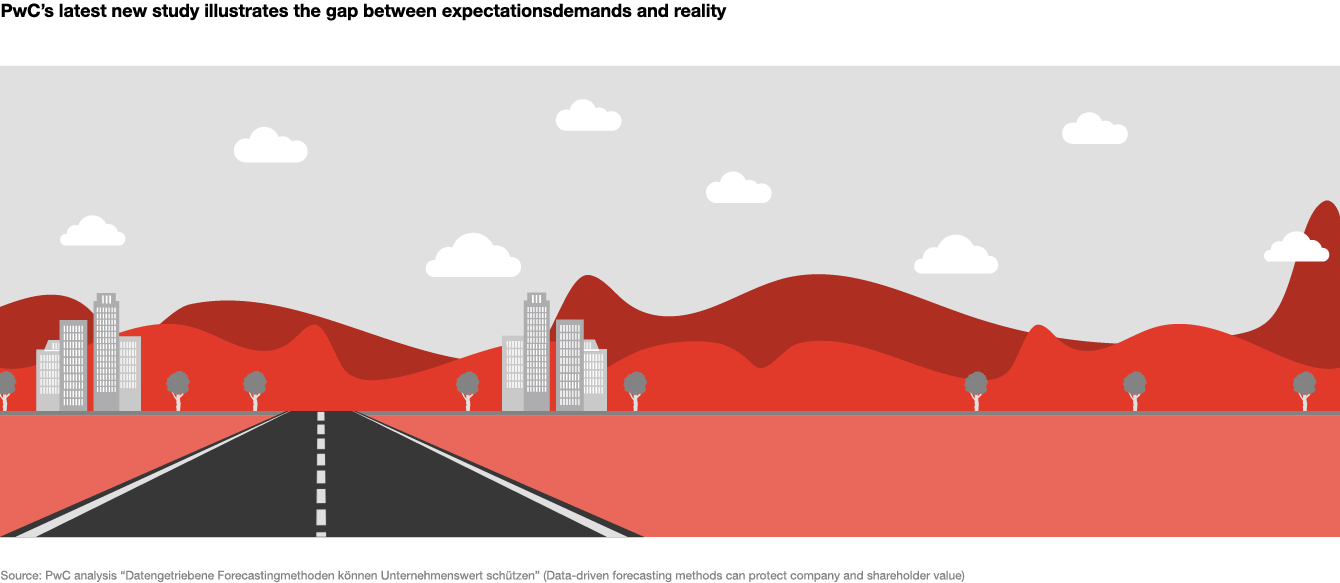
Data-driven forecasting methods can protect company and shareholder value
In dynamic markets, many companies struggle to anticipate developments and generate precise financial forecasts. As a result, companies are often forced to publish ad-hoc disclosures, revising turnover or profits downwards.
“Ad-hoc disclosures can cause dramatic losses of company and shareholder value and weaken trust in the capital markets.”

Your expert for questions

Dr. Frauke Schleer-van Gellecom
Finance Transformation – Predictive Excellence
at PwC Germany
E-Mail
Profit warnings can diminish wipe out company value
PwC recently conducted an analysis of forecasting study in collaboration with the Justus Liebig University of Giessen. Forecasting is becoming increasingly important: the analysis showed that a DAX company with average market capitalisation (€40 billion) must expect ato losse of €158 million after issuing a profit warning. Share prices are considerably more volatile for companies forced to issue profit warnings than they are for companies which can avoid doing so.
Profit warnings also affect stock market stability; it has been proven that particular terminology in ad-hoc disclosures (e.g. “weaker than expected”) negatively affects investors’ trust in a company’s forecasting ability and its general performance.
“The cause of a deviation from the budget can be identified throughwith a clear understanding of the drivers behind it, or by using knowledge gained with using machine learning. Above all, this ultimately enables us to avoid profit warnings, which only occur because we’re looking at past data.”
Data-driven forecasting tools increase confidence among investors
Data-driven tools using artificial intelligence (AI) are a useful preventionpreventative measure for companies. AI-based analyses are more accurate than manual predictions, and they also offer an objective and efficient methodans of forecasting.
This reduces both unexpected variations and the need to publish ad-hoc disclosures, resulting in increased confidence among investors. Value is important to companies, and so they strive to gain a competitive advantage – especially in uncertain times. On average, data-driven forecasting tools offer a financial gain of between €70 million and €85 million over five years for a typical listed company in Germany.
Modern forecasting tools exploit the potential of AI and machine learning to produce more accurate forecasts. Using data-driven approaches to forecasting offers many benefits:
- Efficiency: innovative forecasting tools can efficiently process the huge quantities of data that companies produce in today’s digital age, and use this data to draw accurate conclusions.
- Objectivity: modern tools guarantee an objective approach. Manual forecasting processes, in comparisonon the other hand, may be subjective if employees rely on their gut instincts.
- Speed: by using early warning indicators, companies can actively manage their business and anticipate changing conditions much more quickly.
- Value creation: data-driven tools replace time-consuming, resource-intensive manual processes – giving finance employees more time to concentrate on creating business value.
- Scenario analysis: data-driven forecasting is the foundation of scenario analysis, which supports fact-based decision-making in volatile economic environments.
- Building confidence: statistical forecasting increases confidence among investors by reducing the need for ad-hoc disclosures.
Predictive Excellence
How you can introduce digital forecasting:
- Start with a pilot project to demonstrate the potential of modern tools and improve the quality and accuracy of your forecasting.
- Discuss the results with business experts from a variety of areas.
- Invest in training your team, to prepare your employees for the transition.
- Align your activities with those of the data science team to ensure that you have access to all internal data.
- Find ways of using the information from your forecasting process that enable your finance employees to fulfil their roles as true business partners.
“Data-driven tools make an important contribution to increasing forecast quality and improving process efficiency. They enable companies to avoid profit warnings and protect value.”
Dr. Frauke Schleer-van Gellecom,Finance Transformation – Predictive Excellence at PwC GermanyWhat we can do for you
We will support you in answering these questions, and we’ve also developed a predictive excellence platform based on our Forecast Engine. This tool has proved its worth in drastically increasing forecast accuracy compared to manual approaches, and in identifying relevant value drivers and early warning indicators.
Click here to read more about our predictive excellence platform based on the PwC Forecast Engine.
Contact us


Gori von Hirschhausen
Partner, Europe Finance Consulting Leader, PwC Germany
Tel: +49 89 5790-6698








